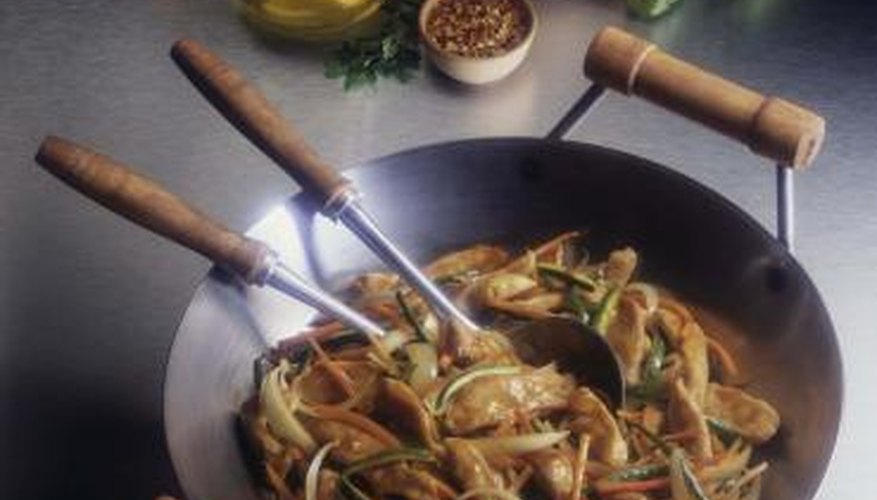The wok is one of the world's most elegant pieces of basic cooking technology. It makes supremely efficient use of both fuel and cooking oil, two things traditionally in short supply throughout much of Asia. A wok can fry, deep-fry, boil or steam foods with equal aplomb, but it is best known for stir-frying, the signature wok cookery technique. Stir-frying has many advantages as a cooking method, and some disadvantages as well.
The Mechanics of Stir-frying
The technique of stir-frying is tied to the design of the wok. A shallow, curved basin, the wok is designed to rest almost on top of a small pile of coals. With a modest degree of fuel, the oil in the very bottom of the wok is heated very hot. The cook rapidly tosses or stirs thinly-sliced vegetables, aromatics, herbs and meats so each piece passes briefly through the hot fat, cooking lightly and quickly.
- The technique of stir-frying is tied to the design of the wok.
- With a modest degree of fuel, the oil in the very bottom of the wok is heated very hot.
Fundamentals of Stir-frying
The actual frying is only a part of what makes stir-frying work. Stir-frying involves a great deal of preparation, and most of the work is done before the wok is heated. To stir-fry successfully, the meats and vegetables must be sliced thinly into strips or on diagonals, to create the greatest possible surface area. The more vegetable exposed to the hot oil, the more quickly it cooks.
- The actual frying is only a part of what makes stir-frying work.
- Stir-frying involves a great deal of preparation, and most of the work is done before the wok is heated.
Advantages of Stir-Frying
The small pool of cooking oil at the bottom of a wok is not only the cooking medium, but a way for flavours to transfer between the foods. The garlic and ginger, vegetables and seasonings infuse the oil and provide light, savoury coating to the food. Stir-fried vegetables retain their colour, a portion of their crispness and all of their water-soluble vitamins. Stir-frying uses a bare minimum of oil, compared to other methods. Finally, in a country which eats relatively few vegetables, a stir-fry is predominantly vegetable based.
- The small pool of cooking oil at the bottom of a wok is not only the cooking medium, but a way for flavours to transfer between the foods.
- The garlic and ginger, vegetables and seasonings infuse the oil and provide light, savoury coating to the food.
Disadvantages of Stir-frying
Although stir-frying has much to recommend it, there are a couple of drawbacks. Some prefer their vegetables fully cooked, for example, and stir-frying is poorly suited for that. For those who own electric stoves, woks adapt poorly to the flat coil burners. Special wok burner elements are available, but aren't practical unless you use a wok daily. Another significant disadvantage is that stir-frying is built around long preparation, then hands-on cooking time. For many home cooks, the slow-cooker model of minimal preparation and unattended cooking holds more appeal.
- Although stir-frying has much to recommend it, there are a couple of drawbacks.
- Special wok burner elements are available, but aren't practical unless you use a wok daily.
